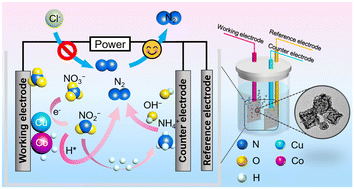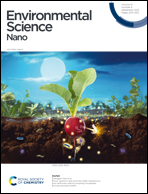Selective tandem electroreduction of nitrate to nitrogen via copper–cobalt based bimetallic hollow nanobox catalysts†
Abstract
Improving the nitrogen (N2) selectivity of the electrocatalytic nitrate reduction reaction (NRR) still remains a significant challenge. The common method of improving N2 selectivity by adding Cl− would generate Cl-based by-products that would cause secondary environmental pollutants. Herein, a novel demonstration of the selective tandem electroreduction of nitrate (NO3−) to N2 using bimetallic hollow nanobox catalysts based on copper and cobalt (Cu–Co HNB) was described. NO3− was first adsorbed on the Cu sites, then reduced to nitrite (NO2−) through electron transfer between interfaces and finally reduced to N2 on the Co sites by the supply-reaction equilibrium atomic hydrogen (H*). Efficient and highly selective removal of NO3− was achieved by combining direct electron reduction and H* reduction through bimetallic tandem catalysis. The Cu–Co HNB electrode demonstrated 98.1% NO3− conversion at a cathodic potential of −1.3 V (vs. SCE) at a NO3−-N concentration of 100 ppm, with almost all of them converted to N2, which was attributed to the synergism of bimetallic active sites and the unique hollow nanostructure of the catalysts. In this work, the bimetallic catalyst Cu–Co HNB exhibited ultrahigh electrocatalytic performance in Cl-free systems through tandem catalysis, providing technical support for environmental nitrate remediation.

- This article is part of the themed collections: Environmental Science: Nano Recent HOT Articles and Nanomaterial applications in water


 Please wait while we load your content...
Please wait while we load your content...